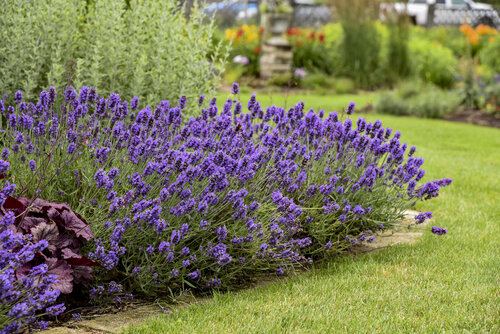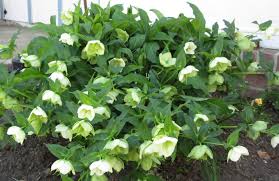
There is nothing worse than walking in to the garden to discover that deer have devoured your favorite plants. And it’s not your imagination … finding plants that deer won’t eat is getting harder each year as more of their habitat becomes developed and their population goes unchecked. Short of installing a nine-foot-tall fence and repeatedly applying repellants, there are few sure cures for this problem. However, by having plants that are deer-resistant, plants that they do not like to eat, you increase your chances of escaping pest damage.
To be clear, deer-resistant does not mean Bambi never eats them. The term is meant to call attention to plants deer find less attractive. A starving deer will eat just about anything.
So, here a few types of plants to consider if deer are a problem in your area.
Four traits that deer hate:

1. Plants with an Herbal Scent
Ornamental herbs that we often just think of as pretty flowering perennials are usually safe to plant around deer. A few of the most common include: catmint (Nepeta), bee balm (Monarda), lavender (Lavandula), salvia/sage (Salvia), creeping thyme (Thymus), ornamental onion (Allium), Russian sage (Perovskia), ornamental oregano (Origanum), anise hyssop (Agastache) and yarrow (Achillea). There are a few types of annuals that share this trait including summer snapdragon (Angelonia), lantana, annual salvias and verbena.
These plants all have a notable herbal or citrus scent when their foliage is cut or crushed. Thankfully, deer and sometimes rabbits usually avoid such plants.

2. Plants with Fuzzy Foliage
Who likes a mouthful of cotton balls? Some types of plants have foliage that is covered in tiny hairs that make them feel fuzzy, scratchy or prickly in a deer’s mouth. If they are hungry enough, they will eat them anyway. More often, the deer will move on to more palatable plants with smooth, succulent leaves instead.
Some plants with fuzzy foliage that deer typically avoid include: heartleaf brunnera (Brunnera), lungwort (Pulmonaria), lamb’s ear (Stachys), deadnettle (Lamium), wormwood (Artemisia), blanket flower (Gaillardia), coleus (Plectranthus), butterfly bush (Buddleia), spirea (Spiraea) and viburnum.

3. Poisonous Plants
You might be surprised to know that some of your favorite foods and flowers are actually classified as poisonous or as an irritant if ingested improperly. Deer intuitively know which of these plants can make them sick or meet a worse fate, and they usually avoid them as a result. If you have small children or curious pets, you may want to avoid planting from this list of plants. If that’s not a concern but deer are, plant away!
Common edible plants that are poisonous or irritating if ingested improperly: Those in the nightshade family, including peppers, potatoes, eggplant, tomatoes and other less common plants like huckleberries and tomatillos.
Common non-hardy plants that are poisonous or irritating: angel’s trumpet (Brugmansiaand Datura), tobacco plant (Nicotania), caladium, castor bean (Ricinus), lantana, oleander (Nerium), plus many types of houseplants.
Common hardy plants that are poisonous or irritating: daffodil (Narcissus), monkshood (Aconitum), bleeding heart (Dicentra), foxglove (Digitalis), spurge (Euphorbia), Lenten and Christmas roses (Helleborus), irises, milkweed (Asclepias), peonies (Paeonia), azaleas and rhododendrons, wisteria and yew (Taxus)

4. Plants with Fine Texture
When the goal is to fill your belly between sunset and sunrise, you go for the big ticket items first—those with plenty of succulent foliage, fruit or flowers. That’s why deer tend to ignore plants with finely textured leaves like ornamental grasses or wispy flowers like baby’s breath. They would need to consume a whole lot of those plants to ease their hunger.
Here are some more finely textured plants that deer tend to leave alone: blue star (Amsonia), pinks (Dianthus), tickseed (Coreopsis), Jacob’s ladder (Polemonium), clematis, ferns, vinca, boxwood (Buxus), deutzia, forsythia, buckthorn (Rhamnus), false cypress (Chamaecyparis), juniper (Juniperus), Siberian cypress (Microbiota), potentilla, scotch broom (Cytisus), euphorbia and Texas primrose (Calylophus).
Although we’re sure the deer won’t appreciate or enjoy this article, we hope that you have! Looking to add one, a few, or all of the plants above to your landscape? We can help you with that! Have any questions or need some other advice? We can help you with that too. We do installations year-round and are always welcoming new clients! Ready to get started on your new project? Give us a call today! 919-844-3441 or fill out the contact form below!
OLDER BLOG POSTS ABOUT PLANTS DEER WILL AVOID…for more information on different plants and strategies click on the following links
https://www.designscapesofnc.com/uncategorized/oh-deer/
https://www.designscapesofnc.com/wildlife/hang-on-for-deer-life/

